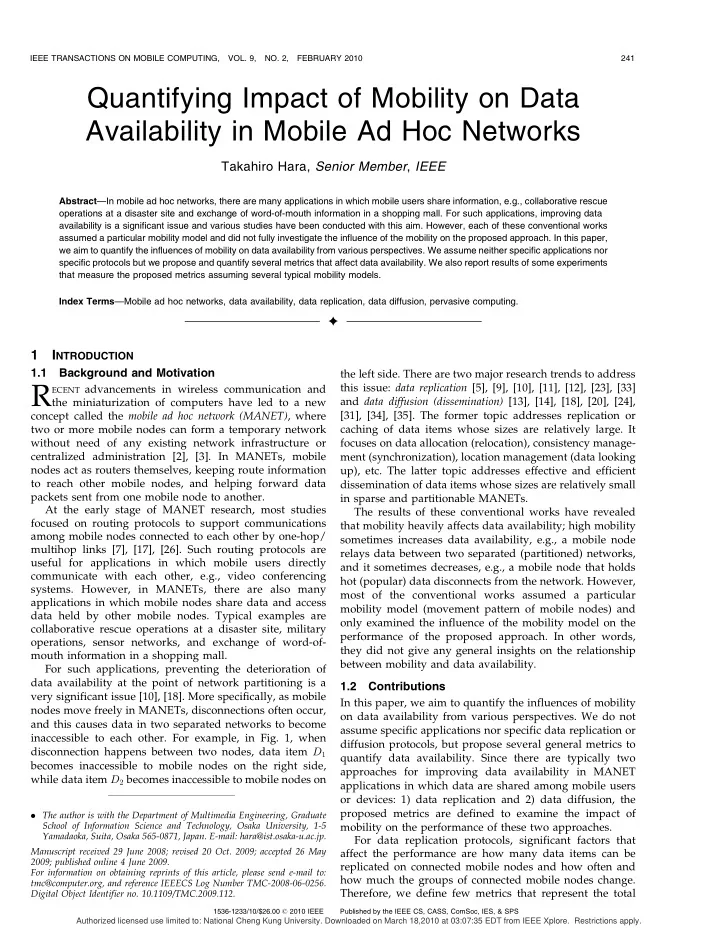

IEEE TRANSACTIONS ON MOBILE COMPUTING, VOL. 9, NO. 2, FEBRUARY 2010 241 Quantifying Impact of Mobility on Data Availability in Mobile Ad Hoc Networks Takahiro Hara, Senior Member , IEEE Abstract —In mobile ad hoc networks, there are many applications in which mobile users share information, e.g., collaborative rescue operations at a disaster site and exchange of word-of-mouth information in a shopping mall. For such applications, improving data availability is a significant issue and various studies have been conducted with this aim. However, each of these conventional works assumed a particular mobility model and did not fully investigate the influence of the mobility on the proposed approach. In this paper, we aim to quantify the influences of mobility on data availability from various perspectives. We assume neither specific applications nor specific protocols but we propose and quantify several metrics that affect data availability. We also report results of some experiments that measure the proposed metrics assuming several typical mobility models. Index Terms —Mobile ad hoc networks, data availability, data replication, data diffusion, pervasive computing. Ç 1 I NTRODUCTION 1.1 Background and Motivation the left side. There are two major research trends to address this issue: data replication [5], [9], [10], [11], [12], [23], [33] R ECENT advancements in wireless communication and and data diffusion (dissemination) [13], [14], [18], [20], [24], the miniaturization of computers have led to a new concept called the mobile ad hoc network (MANET) , where [31], [34], [35]. The former topic addresses replication or caching of data items whose sizes are relatively large. It two or more mobile nodes can form a temporary network without need of any existing network infrastructure or focuses on data allocation (relocation), consistency manage- centralized administration [2], [3]. In MANETs, mobile ment (synchronization), location management (data looking nodes act as routers themselves, keeping route information up), etc. The latter topic addresses effective and efficient to reach other mobile nodes, and helping forward data dissemination of data items whose sizes are relatively small packets sent from one mobile node to another. in sparse and partitionable MANETs. At the early stage of MANET research, most studies The results of these conventional works have revealed focused on routing protocols to support communications that mobility heavily affects data availability; high mobility among mobile nodes connected to each other by one-hop/ sometimes increases data availability, e.g., a mobile node multihop links [7], [17], [26]. Such routing protocols are relays data between two separated (partitioned) networks, useful for applications in which mobile users directly and it sometimes decreases, e.g., a mobile node that holds communicate with each other, e.g., video conferencing hot (popular) data disconnects from the network. However, systems. However, in MANETs, there are also many most of the conventional works assumed a particular applications in which mobile nodes share data and access mobility model (movement pattern of mobile nodes) and data held by other mobile nodes. Typical examples are only examined the influence of the mobility model on the collaborative rescue operations at a disaster site, military performance of the proposed approach. In other words, operations, sensor networks, and exchange of word-of- they did not give any general insights on the relationship mouth information in a shopping mall. between mobility and data availability. For such applications, preventing the deterioration of data availability at the point of network partitioning is a 1.2 Contributions very significant issue [10], [18]. More specifically, as mobile In this paper, we aim to quantify the influences of mobility nodes move freely in MANETs, disconnections often occur, on data availability from various perspectives. We do not and this causes data in two separated networks to become assume specific applications nor specific data replication or inaccessible to each other. For example, in Fig. 1, when diffusion protocols, but propose several general metrics to disconnection happens between two nodes, data item D 1 quantify data availability. Since there are typically two becomes inaccessible to mobile nodes on the right side, approaches for improving data availability in MANET while data item D 2 becomes inaccessible to mobile nodes on applications in which data are shared among mobile users or devices: 1) data replication and 2) data diffusion, the proposed metrics are defined to examine the impact of . The author is with the Department of Multimedia Engineering, Graduate School of Information Science and Technology, Osaka University, 1-5 mobility on the performance of these two approaches. Yamadaoka, Suita, Osaka 565-0871, Japan. E-mail: hara@ist.osaka-u.ac.jp. For data replication protocols, significant factors that Manuscript received 29 June 2008; revised 20 Oct. 2009; accepted 26 May affect the performance are how many data items can be 2009; published online 4 June 2009. replicated on connected mobile nodes and how often and For information on obtaining reprints of this article, please send e-mail to: how much the groups of connected mobile nodes change. tmc@computer.org, and reference IEEECS Log Number TMC-2008-06-0256. Therefore, we define few metrics that represent the total Digital Object Identifier no. 10.1109/TMC.2009.112. 1536-1233/10/$26.00 � 2010 IEEE Published by the IEEE CS, CASS, ComSoc, IES, & SPS Authorized licensed use limited to: National Cheng Kung University. Downloaded on March 18,2010 at 03:07:35 EDT from IEEE Xplore. Restrictions apply.
Recommend
More recommend